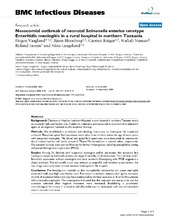Nosocomial outbreak of neonatal Salmonella enterica serotype Enteritidis meningitis in a rural hospital in northern Tanzania
Peer reviewed, Journal article
Permanent lenke
https://hdl.handle.net/1956/2267Utgivelsesdato
2007-09-14Metadata
Vis full innførselSamlinger
Originalversjon
https://doi.org/10.1186/1471-2334-4-35Sammendrag
Background: Clinicians at Haydom Lutheran Hospital, a rural hospital in northern Tanzania noted an unusually high case-fatality rate of pediatric meningitis and suspected an outbreak of an unknown agent or an organism resistant to the empirical therapy. Methods: We established a provisional microbiology laboratory to investigate the suspected outbreak. Blood and spinal fluid specimens were taken from children below the age of seven years with suspected meningitis. The blood and spinal fluid specimens were inoculated in commercial blood culture bottles and locally prepared Thayer-Martin medium in slanted tubes, respectively. The bacterial isolates were sent to Norway for further investigation, including susceptibility testing and pulsed-field gel-electrophoresis (PFGE). Results: Among 24 children with suspected meningitis and/or septicemia, five neonates had meningitis caused by Salmonella enterica serotype Enteritidis, all of whom died. Two children had S. Enteritidis septicemia without meningitis and both survived. Genotyping with PFGE suggested a clonal outbreak. The salmonella strain was resistant to ampicillin and sensitive to gentamicin, the two drugs commonly used to treat neonatal meningitis at the hospital. Conclusion: The investigation reminds us that nontyphoidal salmonellae can cause meningitis associated with very high case-fatality rates. Resistance to multiple antimicrobial agents increases the risk of treatment failure and may have contributed to the fatal outcome in all of the five patients with salmonella meningitis. The investigation indicated that the outbreak was nosocomial and the outbreak subsided after hygienic measures were instituted. Establishing a provisional microbiological laboratory is a valuable and affordable tool to investigate and control outbreaks even in remote rural areas.
